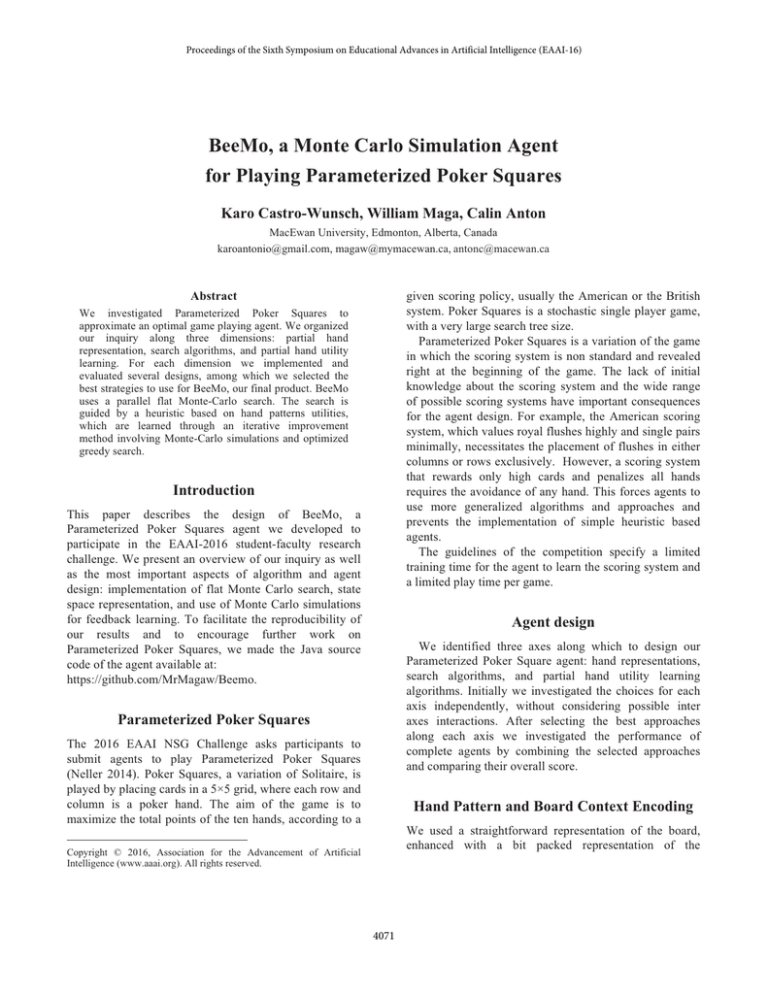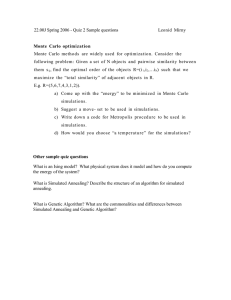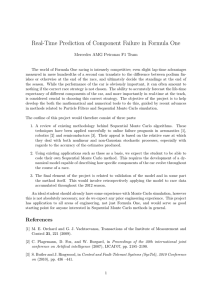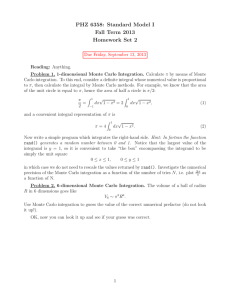
Proceedings of the Sixth Symposium on Educational Advances in Artificial Intelligence (EAAI-16)
BeeMo, a Monte Carlo Simulation Agent
for Playing Parameterized Poker Squares
Karo Castro-Wunsch, William Maga, Calin Anton
MacEwan University, Edmonton, Alberta, Canada
karoantonio@gmail.com, magaw@mymacewan.ca, antonc@macewan.ca
given scoring policy, usually the American or the British
system. Poker Squares is a stochastic single player game,
with a very large search tree size.
Parameterized Poker Squares is a variation of the game
in which the scoring system is non standard and revealed
right at the beginning of the game. The lack of initial
knowledge about the scoring system and the wide range
of possible scoring systems have important consequences
for the agent design. For example, the American scoring
system, which values royal flushes highly and single pairs
minimally, necessitates the placement of flushes in either
columns or rows exclusively. However, a scoring system
that rewards only high cards and penalizes all hands
requires the avoidance of any hand. This forces agents to
use more generalized algorithms and approaches and
prevents the implementation of simple heuristic based
agents.
The guidelines of the competition specify a limited
training time for the agent to learn the scoring system and
a limited play time per game.
Abstract
We investigated Parameterized Poker Squares to
approximate an optimal game playing agent. We organized
our inquiry along three dimensions: partial hand
representation, search algorithms, and partial hand utility
learning. For each dimension we implemented and
evaluated several designs, among which we selected the
best strategies to use for BeeMo, our final product. BeeMo
uses a parallel flat Monte-Carlo search. The search is
guided by a heuristic based on hand patterns utilities,
which are learned through an iterative improvement
method involving Monte-Carlo simulations and optimized
greedy search.
Introduction
This paper describes the design of BeeMo, a
Parameterized Poker Squares agent we developed to
participate in the EAAI-2016 student-faculty research
challenge. We present an overview of our inquiry as well
as the most important aspects of algorithm and agent
design: implementation of flat Monte Carlo search, state
space representation, and use of Monte Carlo simulations
for feedback learning. To facilitate the reproducibility of
our results and to encourage further work on
Parameterized Poker Squares, we made the Java source
code of the agent available at:
https://github.com/MrMagaw/Beemo.
Agent design
We identified three axes along which to design our
Parameterized Poker Square agent: hand representations,
search algorithms, and partial hand utility learning
algorithms. Initially we investigated the choices for each
axis independently, without considering possible inter
axes interactions. After selecting the best approaches
along each axis we investigated the performance of
complete agents by combining the selected approaches
and comparing their overall score.
Parameterized Poker Squares
The 2016 EAAI NSG Challenge asks participants to
submit agents to play Parameterized Poker Squares
(Neller 2014). Poker Squares, a variation of Solitaire, is
played by placing cards in a 5×5 grid, where each row and
column is a poker hand. The aim of the game is to
maximize the total points of the ten hands, according to a
Hand Pattern and Board Context Encoding
We used a straightforward representation of the board,
enhanced with a bit packed representation of the
Copyright © 2016, Association for the Advancement of Artificial
Intelligence (www.aaai.org). All rights reserved.
4071
reduce complexity. Empirical evidence shows that the
contextual information increases the number of unique
patterns from 60 to around 550. Our experiments with
several search algorithms and learning approaches
indicate that the added contextual information leads to
more consistent training and results in better overall
performance.
The hand pattern uses only 16 bits but, for simplicity,
we represented it as a 32 bit integer in our final Java
implementation.
remaining deck of cards which allows fast search and
comparison.
The simplistic representation of a hand as a list of cards
is undesirable due to its size and inconsistency: similar
hands (for example one pair) have many different
representations. Therefore, we implemented a new hand
encoding scheme based on the concept of hand patterns.
Each partial hand was reduced to an abstract
representation, referred to as a hand pattern, which
retained only the important information. The patterns are
based on the following principles:
• The order of the cards is irrelevant
• The rank of the cards is irrelevant, with the only
exception being the possibility of pairs, three or four of
a kind and straights
• The suit of the cards is irrelevant as long as enough
information is retained to determine whether a flush is
possible.
Therefore, the information used to represent a pattern is:
• If it has a flush – 1 bit
• If it has a straight – 1 bit
• The number of cards without a pair – 3 bits
• Number of pairs – 2 bits
• If it has three of a kind - 1bit
• If it has four of a kind – 1bit
• If it is a row or a column – 1 bit.
Notice that our hand pattern encoding does not identify a
royal flush. We chose not to include this information
because our experiments indicated that the marginal
performance increase it creates is significantly
outweighed by the additional computational time. This is
due to the extreme rarity of royal flushes.
This hand pattern encoding is too coarse as it misses
context information. For example, a three of a kind with
the possibility of becoming a four of a kind is encoded
exactly the same as a three of a kind with no possibility of
becoming a four of a kind. These two hands have different
values and should be identified accordingly. We extended
the basic pattern encoding to incorporate the following
information about the cards left in the deck:
• Number of cards of the primary rank – 2 bits
• Number of cards of the secondary rank – 2 bits
• Number of cards that can lead the hand to be a flush – 2
bits representing: 0 if there are not enough cards left of
the relevant suit to complete a flush, 1 if there are just
enough cards left to complete a flush, and 2 if there is
an excess of cards left to complete a flush.
The primary rank is the rank with the most number of
repetitions in a hand and the secondary rank is the rank
with the second highest number of repetitions. Hands in
which there are more than 3 ranks, and therefore have no
possibility of becoming a full house or four of a kind,
have the number of cards in the secondary rank set to 0 to
Search Algorithms
We developed several classes of search algorithms:
simple rule based, expectimax, optimized greedy (OG),
and Monte Carlo variations (Brown et al. 2012). For
comparing the algorithms we employed a set of hand
pattern utilities derived from our own experience with the
game of poker under the American scoring system.
Rule Based Search
It uses if-else statements in order to direct the search
along a specific game play path and/or strategy. The
strategy employed was custom suited to the ‘expert
knowledge’ we could extract from our own experience
playing the game on the American scoring system.
Despite being very fast, the agent is extremely rigid and
non-adaptable to new scoring systems. The algorithm
scored an average of less than 100 points taking almost 1
second to complete 10,000 games. This algorithm was
also used to guide Monte Carlo simulations.
Expectimax Tree Search
Our implementation of the algorithm evaluates all nodes
at a fixed depth and back propagates the values up to the
top node. When a chance node is encountered, values of
all child nodes are averaged and the result is propagated
up. When a choice node is encountered, the value of the
best child is propagated up. This approach achieved a
score of 119.1, at a search depth of 2, taking 30 minutes to
play 10,000 games.
Optimized Greedy
This is a simple greedy algorithm that uses hand pattern
values to evaluate, compare and choose play positions.
Any new card taken from the deck can be placed in up to
25 positions. The value of each position depends on only
two hands, one row and one column, which intersect at
that position. The contribution of each of these hands to
the position’s value is the difference between the utilities
of the hands after and before placing the card. The sum of
these two differences is used to express the value of each
position. The new card is placed at the highest valued
position. The pattern utilities are stored in a hash, so the
main computational load of the algorithm is the encoding
of the hands into patterns, which is done efficiently
4072
lower scores than flat MC. Moreover, evaluating all nodes
before every simulation (to decide which one to explore)
significantly increased the running time and complicated
the parallelization of simulations.
through bit manipulations. The algorithm plays tens of
thousands games per second, and scores an average of
119 points on 10,000 games. Its speed and adaptability to
different scoring systems make it an excellent choice for
guiding Monte Carlo simulations.
BeeMo
For our final implementation we decided to use the flat
Monte Carlo search with simulated games guided by the
optimized greedy search. The main factors in our decision
were: superior performance, reasonable running time and
flexibility of adapting the algorithm to other scoring
systems. Additionally, BeeMo’s speed was significantly
improved through parallelization which was deeply
integrated due to the simple nature of flat MC search.
BeeMo takes full advantage of multi core processors, by
creating several threads for game simulations, which are
then run in parallel on the available cores. In Table i, we
present a comparison of average scores of some algorithm
implementations using the American score system on a
test batch of 10,000 games. For MC search variations 100
games were simulated at each node.
Monte Carlo
Monte Carlo techniques have been proved useful for
stochastic, large state-space problems like Poker Squares.
They produce a fairly accurate model of the state-space
without analyzing every single node. Thus, we used
Monte Carlo methods for searching as well as learning
hand pattern utilities.
Flat Monte Carlo
The simplest form of Monte Carlo search we
implemented was modeled after the Imperfect
Information Monte Carlo algorithm (Furtak and Buro
2013). The algorithm explores a given choice node by
playing a large number of simulated games from each of
its children, estimating the value of a child as the average
score of the corresponding simulations, and selecting the
move which results in the highest value child. The flat
characteristic of the algorithm stems from the uniform
distribution of games among child nodes. Any of the
algorithms described above can be used to guide the
simulated games provided they are reasonably fast
(expectimax is thus unsuitable). We implemented flat MC
search with a random player, a rule based search, and an
optimized greedy search. While fast, the random player
based variant had poor performances; half the score of the
other approaches. The rule based search MC and the
optimized greedy based MC had comparable
performances, but different time requirements (see Table
i).
UCT Monte Carlo
One of the most powerful and widely implemented
improvements of the classic Monte Carlo approach is the
Upper Confidence Threshold (UCT) (Kocsis and
Szepesvari 2006). It alters the uniform distribution of
node selection by trying to balance the exploitation of
nodes with high average score and the exploration of
nodes with low average score. The flat Monte Carlo
algorithm described above is, in this respect, entirely
exploratory as it visits each node the same number of
times. For example, suppose that after 400 simulations for
each node, one of them has an average score of 50 while
all the others have scores above 100. The low score node
is an obvious non-contender. Despite this information, flat
MC search will distribute the remaining simulations
uniformly among all nodes. UCT allows the search
algorithm to focus on higher score nodes without
completely disregarding lower score ones. However, our
own implementations of UCT turned out to be more
problematic than expected as they always resulted in
Algorithm
Average
Score
Running time for
10,000 games
Rule Based
<100
~1 second
Expectimax
117
30 minutes
OG
119
~ 1 second
Flat MC + Rule Based
123
~ 7 hours
Flat MC + OG
125.3
~ 8 hours
BeeMo (Parallel Flat MC +
OG)
125.3
~ 4 hours
Table i. Relative performance of search algorithms.
Learning
Due to the unknown scoring scheme, learning the partial
hands’ utilities is highly important to the performance of
the agent. The Monte Carlo simulation was used for
learning, albeit from a slightly different angle: the
simulations were employed to estimate the utility of each
partial hand pattern. The learning algorithm uses rounds
of 10,000 Monte Carlo simulations. Each round consists
of a training phase followed by an evaluation phase.
In the training phase, 5,000 simulated games are played,
through which the hand pattern utilities are produced. At
the beginning of the training phase all pattern utilities are
arbitrarily set to zero. In every simulated game, the utility
of each partial hand is set to the corresponding final hand
value. For example, if a partial hand consisting of only a
5H, results (at the end of the game) in a flush with a score
of 20, its utility is set to 20 points. At the end of a
simulated game, each pattern utility is computed as the
average of the scores of complete hands that resulted from
hands which matched the pattern. The updated set of
4073
exploration term parameter (Cp), which we optimized
empirically.
As shown in Table iii, UCB1 slightly increased the
number of patterns seen. However its influence on
performance was positive for some scoring systems and
negative for others.
pattern utilities is used to guide the greedy search in the
next simulated game. This leads to a positive feedback
loop which greatly improves the score of the agent. This
feedback loop is the most potentially novel component of
the agent. In Table ii, we present a comparison of average
scores with and without feedback loop on tests batches of
10,000 games. With the only exception of custom scoring
system, which alternates negative and positive scores, and
has a large penalty for high cards, the feedback loop
improves the average scores.
# patterns seen
American Score
British Score
Custom
High Card
Hyper Corner
Flat MC
350
120.2
47.8
160.1
83.1
-0.53
BeeMo’s training
To benefit from both approaches, BeeMo uses both
evaluations schemes; one in three simulated games uses
UCB1. The interplay between alternating searching and
training components produces an initially random-like
behavior which becomes more robust as patterns’ utility
estimations become more accurate. As Figure 1 illustrates,
BeeMo’s learning algorithm belongs to the class of
iterative improvement methods.
UCB1
352
121.5
47.8
153.0
89.9
-0.63
Table ii. Average scores of training with and without feedback.
In the evaluation phase 5,000 games are played, using
the set of hand pattern utilities produced during the
training phase. The overall score of a set of hand pattern
utilities is estimated as the average of the evaluation
games’ score. The set of pattern utilities with the
maximum overall score is kept for the final playing agent.
Figure 1. Pattern Utility Estimation Feedback Loop
Flat Monte Carlo training
Due to the advantages presented above, we chose flat
Monte Carlo simulation as our first training approach. It
created hand pattern utilities which resulted in average
scores comparable to our hand crafted values. For the
American score system parallel flat MC with OG
guidance obtained an average score of 125 points when it
used the crafted hand pattern utilities and an average
score of 120 points when it used the flat MC learning. The
running time was reduced from about 7 seconds to just
below 1 second. The accuracy of this utility estimation
scheme depends on the number and frequency of hands
that are matched to a certain pattern. Some low frequency
but possibly high utility patterns are only rarely updated,
which may result in unreliable utility estimations.
Score System
Without Feedback
With Feedback
American
93.7
115.3
British
40.5
43.4
Custom
157.9
154.4
High Card
8.9
14.3
Hyper Corner
-0.97
-0.61
Conclusions
We implemented an optimized greedy search algorithm
guided by learned hand pattern utilities. Based on our own
implementation and testing of various search algorithms,
flat Monte Carlo search guided by optimized greedy was
determined to be the most effective approach. For utility
learning we used a combination of flat Monte Carlo
simulations and modified UCB1 scheme which
effectively improved the performance of the final agent.
References
Neller, T. 2014. NSG Challenge: Parameterized Poker Square,
http://cs.gettysburg.edu/~tneller/games/pokersquares/eaai/param
PokerSquares.pdf
Browne, C.; Powley, E.; Whitehouse, D.; Lucas, S.; Cowling, P.;
Rohlfshagen, P.; Tavener, S.; Perez, D.; Samothrakis, S. and
Colton, S. 2012. A Survey of Monte-Carlo Tree Search
Methods. IEEE Trans. on Computational Intelligence and AI in
Games, 4(1):1-43.
Auer, P; Cesa-Bianchi, N. and Fischer, P. 2002. Finite-time
Analysis of the Multiarmed Bandit Problem. Mach. Learn.
47(2):235–256.
Furtak, T. and Buro, M. 2013, Recursive Monte Carlo Search
for Imperfect Information Games. In Proceedings of the IEEE
CIG
Kocsis, L, and Szepesvari, C. 2006. Bandit based Monte Carlo
Planning. ECML-06. Number 4212 in LNCS
Table iii. Training results of Flat MC and UCB1 simulations.
Flat UCT training
To check the accuracy of these estimations we
implemented a UCT evaluation scheme inspired by the
UCB1 variation of the Upper Confidence Bound class
(Auer, Cesa-Bianchi, and Fischer 2002.), with a small
4074







